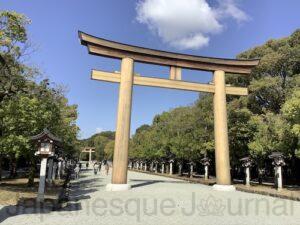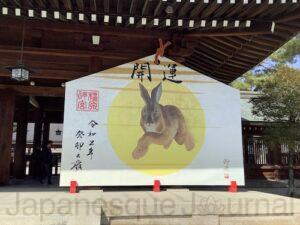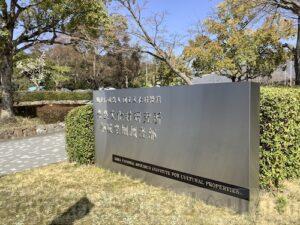Introduction: Kashihara city in Nara
Have you ever wanted to take a journey through Japan’s rich archaeological history? If so, Kashihara should definitely be on your list of places to visit. Kashihara is the second largest city in the Nara Prefecture. It is home to a number of historical sites that are sure to pique the interest of any history buff. Between 694 and 710, there was the Fujiwara capital (藤原京) in Kashihara.
The Kashihara Shrine
This post is a continuation from the previous blog where I departed from Yamato-Yagi station.
I departed from Yamato-Yagi station and headed to Kashihara-Jingu-mae station. The Kashihara Shrine is located a short walk from Kashihara-Jingu-mae station.

Its serene atmosphere was very relaxing. I was amazed at how large the precincts were! After walking on gravel for a while, I finally reached the main hall. In front of the main hall, there was a large ema (votive picture tablet) with a rabbit, the zodiac symbol of the year, depicted on it. This ema is apparently a specialty of Kashihara Shrine, and many people were taking pictures in front of it. After worshiping, I received an goshuin (a shrine stamp) from the shrine.


The Museum, Archaeological Institute of Kashihara, Nara Prefecture: A Must-Visit Destination for History Buffs
A short walk away was The Museum, Archaeological Institute of Kashihara. This is a place that archaeology fans would love, and I had wanted to go for many years. I couldn’t help but take a photo in front of the entrance.


A rich and valuable collection of exhibits!
Although it’s not as spacious as some of the national museums, it’s still quite large. They have carefully selected and displayed a surplus of excavated items, and they have both a quality and quantity that is overwhelming. There were many items that were surprisingly large in size and yet hadn’t broken during excavation.





One of the highlights of the museum is the collection of artifacts from the Kofun period. This period, which lasted from the 3rd to the 7th century AD, was a time of great change in Japan. The museum’s collection includes various artifacts, such as clay figures and large burial mounds, which help to give visitors a better understanding of this important period in Japan’s history. The Fujinoki burial mound (藤ノ木古墳), for which excavation work had just been completed, was featured in the exhibition.
The special exhibition was mainly about the people who came from across the sea, and how technology changed through trade with the Korean Peninsula was displayed in an easy-to-understand manner.
The gift shop had a great selection of products. By “great,” I mean that there were many original museum items that were likely curated by experts. I ended up buying a lot of keychains and postcards.
The Misanzai Kofun
After leaving the museum, I headed to the Misanzai Kofun, which was within walking distance. Note that there is more than one burial mound named Misanzai Kofun. The sign read “Emperor Jimmu’s Tomb,” and it was under the jurisdiction of the Imperial Household Agency, as expected. The grounds were spacious, and the air was as calming as at Kashihara Jingu. However, it was locked and I couldn’t go inside, so it was a bit boring.


The Mount Amanokagu and The Exhibition Room of Fujiwara Imperial Site
Mount Amanokagu
I walked for nearly 30 minutes from there, planning to go to the Fujiwara capital. but I decided to go a little further and see Mount Amanokagu (天香久山) first. The mountain is known for appearing in a Japanese poem written by Emperor Jito in a famous collection of poems. It was more like a hill than a mountain. If you looked southeast from the Fujiwara capital, you could see the Mount Amanokagu right next to it. It was a great experience to feel that the Emperor Jito had composed a poem about this view.

The Exhibition Room of Fujiwara Imperial Site, the Nara National Research Institute for Cultural Properties
On the way, I found the Exhibition Room of Fujiwara Imperial Site run by the Nara National Research Institute for Cultural Properties. There seemed to be volunteer guides, but there were a few groups ahead of me, and there were no guides available. So I looked around on my own. It was free, and they had exhibits from the Fujiwara Capital.

According to the diorama, the main palace was not on the north side, but rather in the center. Normally, the main palace should be on the north side of the capital, not in the center, but this is not the case in Fujiwara capital. I had heard in an archaeology lecture that the Fujiwara Capital was modeled after the Chinese capital. However, at that time, the Chinese did not show the blueprints of the capital to the Japanese, who were foreigners. Therefore, the Japanese built the capital with an incomplete design.

The Fujiwara Capital
After leaving the museum, I walked to the Fujiwara Capital site. It is a large area, so the distance is quite far, but it’s a great place to take a stroll. Compared to the Heijo Capital in Nara city, it’s narrower, but the site remains as a square and it’s interesting to see the restored foundations of the buildings. Local people were playing soccer and walking their dogs there. It’s moving to think that we are spending our daily lives in the same place where ancient people once built their capital.




There is a pond on the north side of Fujiwara Capital site. So I went to see the rapeseed flowers blooming there.

I walked back to Miminashi Station and returned Osaka. It’s convenient that we can go from Kashihara to the south side of Osaka, Tsuruhashi, by transportation.
Conclusion
In conclusion, Kashihara is a city that is steeped in history, and it is the perfect destination for anyone looking to explore Japan’s rich archaeological past. Whether you are a history buff or just someone who enjoys learning about the past, Kashihara has something for everyone.


